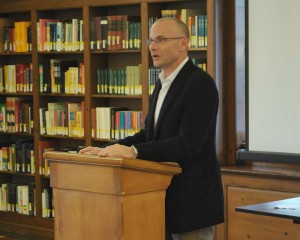Treuer, David. “The Cultural Twilight.” University of California in Los Angeles. UCLA American Indian Studies Center, Los Angeles, CA. Gathering Native Scholars and Artists–A Celebration of Forty Years. 22 Oct. 2009. Conference Speaker.
In his speech to the 2009 Gathering of Native/American Scholars and Artists: 40th Anniversary symposium (celebrating forty years of American Indian Studies at UCLA), Treur outlines the history of the field of Native American literature and criticism, the current state, and his predictions and hopes for the future of the field.
Treuer opens his talk by quoting from Paul Apodoca’s preceding talk, “The Future of American Indian Studies,” referencing Apodoca’s idea of two approaches in Native American studies: the understanding that Native American Studies programs give the Native Community a voice (“‘activist positioning’”), and the understanding that “‘Native Studies is a legitimizing practice’” (48). Treuer references these two approaches in order to explain how the field arrived at its earliest methodology, in which “to claim space for its expression, American Indian literature and criticism argued…that its subject and method was other, different, because its subject was its method,” for “the structure and sense and politics of the thing was Indian and derived from Indian ways of thinking and making meaning” (48).
However, though Treuer concedes that this methodology was the acceptable during the Renaissance of the 1960s, it’s no longer acceptable, especially in light of the current conditions of reservations and urban communities–what he argues must now be the true work of American Indian Literature. As he contends, “what was happening in the academy in the 1980s and 1990s often had precious little to do with the mean struggles…to suggest that Indian academia and living Indian communities are on the same page, are even of the same paper, might dangerously privilege the academy and undervalue and undermine the concerns of Native American communities, many of which are struggling with issues of poverty and power and the fight to hold on to languages and cultures” (49).
Treuer’s critique of privileging the concerns of the academy over the concerns of Native American communities rings uncomfortably true. In my travels this summer, I had the pleasure of seeing the Grand Canyon, and the absolute horror of seeing part of the Hualapai reservation as we drove to and from the entrance of one of the world’s most visited parks. Though each person’s entrance fee to the park is easily forty dollars–and though the park sits in the middle of Hualapia land–the community around the park lives in abject poverty. Shacks made of sheet metal, cardboard, and pieces of ragged wood lined the road, many homes were either burnt out, missing doors, windows, and parts of a roof, and the local post office (flying a giant American flag)served as the nearest food supply for forty miles–and serviced a community with less than roughly ten cars.
Treur continues his criticism of the academy and the state of the field throughout the remainder of his speech, in warning against “sentimental” literature and scholarship that has focused perhaps too long on establishing a literary nationalism (50). Through his comparison of Native American studies to the course the Irish Literary Revival or Celtic Twilight, he is concerned with and questions the possibility of acculturation in the field, in which “culture is something we talk about but never do,” hence the fear of a “cultural twilight” in the field (52).
Treur ultimately calls for a “new kind of modernism,” and agrees with American Indian poet Erika Wurth in her push for a “‘fourth wave’” of the field (53). The newest and most exciting work, Treur feels, is currently underway by younger American Indian poets and filmmakers, whose primary work seems to be language and culture recovery, and a real reconnection to their respective communities.
